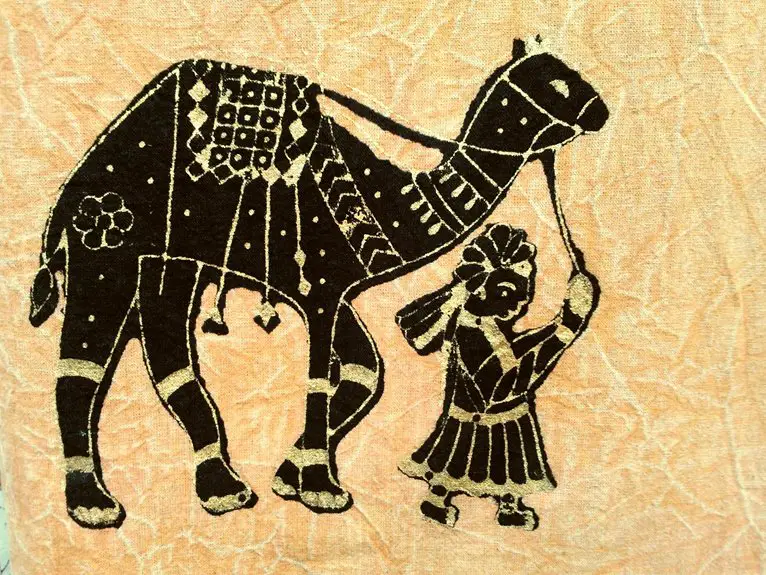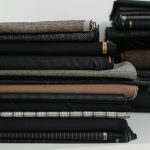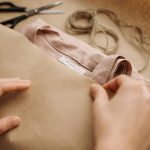You’ll find camel fabric is made from the soft undercoat of camels, primarily collected during their natural shedding season in spring. This wool comes from two camel species, the Bactrian and Dromedary, offering warmth and breathability. The fibers are carefully sorted and processed through traditional or modern methods to create soft, durable fabric. It’s eco-friendly, versatile, and perfect for cozy clothing and home textiles. Keep exploring to discover more about its unique qualities and care tips.
Table of Contents
Key Takeaways
- Camel fabric is made from the soft undercoat wool of camels, primarily from Bactrian and Dromedary species.
- The wool is collected during seasonal shedding through manual combing or mechanical harvesting methods.
- Only the finest fibers are sorted and separated from coarse guard hairs to ensure high-quality fabric production.
- Traditional and modern manufacturing processes include cleaning, carding, spinning, and precision weaving of the camel wool.
- Camel fabric is valued for its natural softness, warmth, breathability, and sustainable sourcing from arid regions.
The Origins of Camel Fabric
Camel fabric traces its roots back thousands of years to the nomadic tribes of Central Asia, who relied on camel wool for warmth and durability. When you wear camel fabric today, you’re connecting with that rich tradition.
These tribes mastered the art of harvesting camel hair, carefully collecting the soft undercoat during shedding seasons. You’ll find that camel fabric’s natural insulating properties made it perfect for harsh climates, keeping you warm without feeling heavy.
Over time, people recognized its unique softness and strength, turning it into luxury textiles. So, when you choose camel fabric, you’re embracing a material shaped by centuries of practical use and cultural significance, crafted to offer comfort and resilience in your everyday life.
Types of Camels Used for Fabric Production
Several species of camels contribute to the production of camel fabric, each offering distinct qualities in their wool.
You’ll mainly encounter two types: the Bactrian camel and the dromedary camel. The Bactrian camel, with its two humps, thrives in colder climates and produces thick, warm wool. This makes its fiber ideal for heavier, insulating fabrics.
On the other hand, the dromedary camel has one hump and is adapted to hot desert environments. Its wool is lighter and softer, perfect for breathable textiles.
When sourcing camel fabric, knowing which camel’s wool you’re dealing with helps you understand the fabric’s potential uses.
Both types are valued for their natural insulating properties, but their environmental adaptations influence the texture and durability of the fabric you’ll get.
Characteristics of Camel Wool
You’ll notice camel wool feels incredibly soft and keeps you warm even in chilly weather.
Its natural insulation properties trap heat while allowing breathability, making it perfect for varying climates.
Let’s explore how these qualities make camel fabric stand out.
Softness and Warmth
Although many fabrics offer comfort, camel wool stands out for its exceptional softness and warmth. When you touch camel wool, you’ll notice its smooth texture, which feels gentle against your skin—far less itchy than traditional wool. This softness comes from the fine, silky fibers found in the undercoat of camels, specially harvested during molting season.
As for warmth, camel wool naturally retains heat, keeping you cozy even in chilly conditions. You won’t need to pile on layers because it traps your body heat efficiently while still allowing breathability.
Natural Insulation Properties
A key reason camel wool excels as a fabric is its natural insulation properties. When you wear camel fabric, you benefit from fibers that trap air, creating a barrier that keeps cold out and warmth in.
This unique structure helps regulate your body temperature, so you stay comfortable whether it’s chilly or slightly warmer. Unlike synthetic materials, camel wool breathes well, preventing overheating and moisture buildup.
Its hollow fiber core acts like a natural thermal regulator, making it ideal for both cold winters and cool summer evenings. When you choose camel fabric, you’re not just getting softness and warmth—you’re also embracing a smart, sustainable way to stay cozy in varying climates.
The Process of Collecting Camel Hair
When collecting camel hair, you’ll want to focus on the seasonal shedding period to gather the finest fibers.
You can choose between manual or mechanical collection methods, each affecting the quality and efficiency.
Afterward, sorting the hair carefully guarantees you get the best material for fabric production.
Seasonal Shedding Period
Since camel hair grows thick and dense, you’ll want to collect it during the seasonal shedding period when the camels naturally lose their undercoat. This usually happens in spring, as camels adapt to warmer temperatures by shedding their insulating hair.
During this time, the fine, soft undercoat loosens and falls off, making it easier for you to gather high-quality fibers without harming the animals.
Timing is essential because collecting too early or too late means you might miss the prime fleece or end up with coarser, less desirable hair.
Manual vs. Mechanical Collection
Although you can collect camel hair by hand or with machines, each method has its unique advantages and challenges.
When you gather hair manually, you use gentle combing or shearing during the camel’s natural shedding season. This approach lets you select the finest, softest undercoat fibers, preserving quality. However, it takes more time and effort, especially with larger herds.
On the other hand, mechanical collection speeds up the process by using specialized machines to remove loose hair efficiently. While this method is faster and ideal for bulk harvesting, it may mix coarse outer hairs with the fine undercoat, affecting fabric quality.
Ultimately, your choice depends on balancing efficiency with the quality standards you want for your camel fabric products.
Quality Sorting Techniques
Three key steps define quality sorting techniques for camel hair collection, ensuring you end up with the finest fibers.
First, you’ll need to carefully separate the undercoat from the coarse guard hairs because the softer undercoat is what makes camel fabric so luxurious.
Next, inspect the fibers for any debris or dirt, removing impurities that could affect the fabric’s texture and durability.
Finally, sort the hair by length and color to maintain consistency in the final material.
To summarize:
- Separate undercoat from guard hairs
- Remove dirt and impurities
- Sort fibers by length and color
Traditional Methods of Processing Camel Fiber
When you handle camel fiber traditionally, the process starts with carefully shearing the camel during molting season to collect the soft undercoat.
Next, you manually sort the fibers to separate the finer undercoat from the coarse outer hairs, ensuring only the best quality is processed.
Manually sorting fibers separates the soft undercoat from coarse hairs, ensuring premium quality camel wool.
After sorting, you gently clean the fibers by hand to remove dirt and debris without damaging their natural softness.
Then, you card the fibers using simple wooden tools, aligning them to prepare for spinning.
Spinning is done by hand or with a traditional spindle, transforming the fibers into yarn.
Finally, you weave or knit the yarn using age-old techniques passed down through generations, creating durable, warm camel fabric with a unique texture and natural insulation.
Modern Techniques in Camel Fabric Manufacturing
You’ll find that modern techniques in camel fabric manufacturing combine advanced machinery with innovative processes to guarantee efficiency and quality.
These methods ensure the fabric retains its natural softness and durability while meeting commercial demands.
When working with camel fiber today, you benefit from:
- Automated fiber sorting that separates fine undercoat from coarse outer hair, improving texture consistency.
- High-speed spinning technology that twists fibers into yarn with minimal breakage, preserving strength.
- Precision weaving machines that create uniform fabric patterns, enhancing both appearance and performance.
Environmental Impact and Sustainability of Camel Fabric
Although camel fabric benefits from modern manufacturing techniques, it also stands out for its positive environmental impact. When you choose camel fabric, you support a natural, renewable resource since camel hair is shed seasonally without harming the animals. This reduces the need for synthetic fibers, which often involve heavy chemical use.
Additionally, camels thrive in arid regions with minimal water and food, so their fabric production demands fewer resources compared to conventional livestock. You’ll also appreciate that camel fabric is biodegradable, meaning it won’t contribute to long-term landfill waste.
While no textile is entirely impact-free, camel fabric’s sustainability makes it a smart choice if you care about reducing your ecological footprint. Choosing camel fabric helps promote eco-friendly fashion that aligns with your values.
Common Uses of Camel Fabric in Fashion and Textiles
Beyond its environmental benefits, camel fabric offers versatility that designers and consumers appreciate alike.
Camel fabric’s versatility wins over designers and consumers, combining style with sustainable comfort.
You’ll find this fabric used in a variety of fashion and textile applications because of its softness, warmth, and durability. When you choose camel fabric, you’re opting for both style and function.
Here are some common uses you might encounter:
- Outerwear: Camel coats and jackets are timeless, providing excellent insulation while looking elegant.
- Knitwear: Sweaters and scarves crafted from camel fabric feel luxuriously soft against your skin.
- Home Textiles: Blankets and throws made from camel wool add warmth and a natural aesthetic to your living space.
These uses highlight how camel fabric blends comfort with sophistication, making it a favorite choice in both fashion and home décor.
Caring for and Maintaining Camel Fabric Products
When you invest in camel fabric products, proper care guarantees they stay soft and durable for years.
Always check the care label before cleaning; most camel fabrics require gentle hand washing or dry cleaning to maintain their texture. Avoid harsh detergents and bleach, which can damage fibers.
If you hand wash, use cold water and mild soap, then lay the garment flat to dry—never wring or twist it.
Store camel fabric items in cool, dry places away from direct sunlight to prevent fading and fiber weakening.
Brush off dirt and lint regularly with a soft garment brush.
Frequently Asked Questions
Can Camel Fabric Be Blended With Other Fibers?
Did you know 70% of luxury textiles blend fibers? Yes, you can blend camel fabric with wool, silk, or synthetic fibers to enhance durability and texture. You’ll get a unique, comfortable fabric suited for various uses.
Is Camel Fabric Hypoallergenic?
You’ll find camel fabric is generally hypoallergenic because it’s natural and breathable, reducing irritation. However, if you have severe allergies, test a small patch first. Its softness usually helps keep allergies at bay.
How Does Camel Fabric Compare to Cashmere?
You’ll find camel fabric is warmer and more durable, while cashmere feels softer and lighter. Both are luxurious, but camel’s natural insulation beats cashmere in cold weather. You’ll choose based on comfort and use.
What Are the Price Ranges for Camel Fabric Products?
You’ll find camel fabric products priced anywhere from $100 for basic scarves to over $1,000 for luxury coats. Prices vary based on quality, brand, and craftsmanship, so shop around to find the best value for your budget.
Are There Any Cultural Significances Tied to Camel Fabric?
You’ll find camel fabric carries deep cultural roots, often symbolizing warmth and resilience in desert communities. It’s like wearing a story woven from tradition, connecting you to centuries of heritage and craftsmanship.







